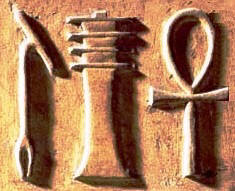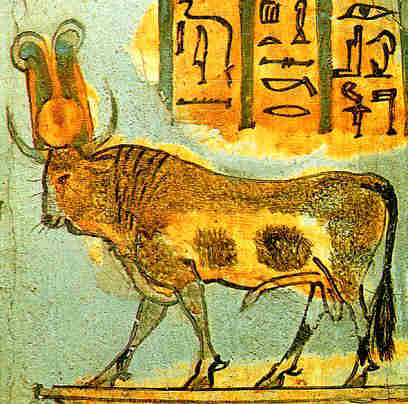
| Ptah, god of Egypt | 
|
|
Ancient Egyptian Gods and Goddesses for kids - Ptah The Mythology & History of ancient Egypt surrounding the Memphis creator god of craftsmen, earth and Underworld |
|
Ptah, god of Egypt
Discover the legends and myths and religious beliefs surrounding Ptah, the Egyptian creator god of craftsmen, the earth and the Underworld. His major cult center was at Memphis, he was the chief god of the Memphis Triad with his wife the lioness goddess Sekhmet and his son Nefertum. The priests of Memphis assimilated all aspects of the Osiris myth in favour of Ptah and the new Memphite Cosmogony (creation myth). The Memphis version of the creation myth existed alongside the Ennead of Heliopolis, but its followers believed that Ptah created Atum and the ocean from which he rose. Over time Ptah assumed the role of Osiris (hence their similarities in pictures) and credited with inventing the 'opening of the mouth' ceremony. Additional, interesting facts and information about ancient Egypt, and its mysterious gods is also available via: |
|
Who was Ptah?
Ptah was the Memphis creator god of craftsmen, the earth and the Underworld. Ptah is depicted in a similar form to Osiris tightly wrapped like a mummy with green skin (the symbol of rebirth and regeneration). Ptah was also depicted holding the Staff of Dominion combining the Was Scepter (power), the Ankh (life) and the Djed (stability). His headdress was a blue cap crown. Facts about Ptah
The following facts and profile provides a fast overview of Ptah:
Ptah Profile & Fact File | | Egyptian Name: | Ptah (pronounced Pitah). Alternative Names: Pteh, Peteh
| | Role & Function: | The function of Ptah is described as being the creator god of craftsmen, the earth and the Underworld
| | Status: | Member of the Memphis Triad of gods. Refer to the Triads of Egyptian Gods
| | Symbols: | The scepter of Dominion combining the Ankh, the Was and the Djed. The Apis Bull was also an important symbol of Ptah
| | Cult Center: | Memphis
| | Titles: | The "Lord of Truth", the "Noble Djed", the "First of the gods" and "He who set all the gods in their places and gave all things the breath of life"
| | Name of Wife: | In the Memphis Triad he was the husband of Sekhmet, lioness of war
| | Names of Children: | The father of Nefertum, god of medicine and perfume. He was also named as the father of Imhotep the deified god of medicine.
| | Name in Hieroglyphics: | 
| Translation of Hieroglyphics for Ptah: Stool (Letter P), bread (giver of food), lamp wick (letter H) and sitting god |
|
|
|
Ptah in Egyptian Mythology
Ptah, the Egyptian creator god was also revered as the god of all craftsmen because he was believed to have crafted the universe and the other gods. He was particularly associated with the building of massive great architectural monuments and temples including the pyramids of Giza. The name Ptah is believed to have derived from the ancient Egyptian word for 'sculptor'. His major cult center was at Memphis where he was revered as the chief god of the Memphis Triad with his wife the lioness goddess Sekhmet and his son Nefertum. The City of Memphis - Centre for the Worship of Ptah
The city of Memphis was founded by the pharaoh Menes around 3000 BC and is 20 km (12 miles) south of Cairo, on the west bank of the Nile. Memphis became the capital of Ancient Egypt for during the period in ancient Egyptian history known as the Old Kingdom "the Age of the Pyramids" which incorporated the 3rd - 6th Egyptian Dynasties established 2686 BC - 2181 BC. The city of Memphis reached a peak of prestige under the 6th dynasty as a centre for the worship of Ptah. The Rise of the god Ptah
When Memphis rose in prominence in ancient Egypt and became the new capital its leaders and priests justified its status by developing a new creation myth. This was a political, financial and religious decision. In order not to provoke the ancient gods, and their highly influential priests, the new Memphis creation myth held that Ptah was the creator god who created other gods. Ptah was aligned with the primordial ocean called Nun in the old Creation myth of Helipolis who gave life to all the gods. Ptah was manifested as the intellectual god, he was more metaphysical than earth dwelling. His ideas conveyed through speech and emotions to the other gods - his thinking and speech brought the cosmos into existence. Ptah was called the "heart and tongue" of the Ennead. The heart and tongue was seen by the ancient Egyptians as the center of the human soul and intellect. Ptah was seen as superior to the god Atum who created his Ennead "by his semen and his fingers". This revelation explained that the world, rather than being created out of chaos, followed the pre-conceived plan of Ptah. Ptah was given the epithet "He who set all the gods in their places and gave all things the breath of life" and initially the 'Ptah Family Tree' included gods and goddesses from both the Ennead of Heliopolis and the Ogdoad of Hermopolis. The major Heliopolitan god Atum held a central position in the new cosmology. In this way Ptah was cleverly given a commanding position amongst the old gods and at the same time avoided serious conflict with the priests of rival cult centers at Heliopolis and Hermopolis. Ptah and Osiris
Ptah became closely linked with the funerary god of Memphis called Sokar, and was eventually subsumed (meaning absorbed) into a new god called Ptah-Sokar. Gradually he formed with Osiris a new deity called Ptah-Sokar-Osiris and eventually took on the persona and duties of Osiris. Ptah was then depicted in a similar form to Osiris tightly wrapped like a mummy with green skin (the symbol of rebirth and regeneration). The Symbols and Dominence of Ptah
The depictions of Osiris and Ptah also have significant differences. Their false beards are different. Pharaohs and gods were depicted with a false beard that was hooked behind the ears. Beards with an upward pointing curl were called an “osird” or “the divine beard". Living pharaohs wore a beard with a straight edge. Only when they died could they wear the “osird”. This symbolizes that Osiris was as god of the Underworld whereas Ptah held dominion over the realms of both the world of the living and the world of the dead. Osiris holds the crook and flail, the regalia of the pharaohs. The crook symbolized the role as 'shepherd' of the people, the flail sign symbolized the role as provider of food. Ptah grasps the Staff of Dominion combing the 'Was Scepter' the symbol of divine power and an emblem of authority, the Ankh representing the power to give life or take it away and the Djed representing stability and endurance. The Djed was originally identified as the 'symbolic backbone of Osiris' and played a prominent feature in ancient Egyptian mythology, ceremonies and rituals. To emphasize the change still further Ptah was given the title of the "Noble Djed". The symbols and depictions of Ptah emphasized his superiority over the god Osiris and his dominant position as the principal god of Memphis was further intensified. The political importance of Memphis caused the cult of Ptah to expand over the whole of Egypt. 
Ancient Egyptian symbols associated with Ptah: Was Sceptre, the Djed and the Ankh Ptah and the Triad of Memphis
In time the creation myth developed and Ptah acquired a consort (Sekhmet) and a son (Nefertum) - the Memphis triad. The Triad of Memphis centred around the cult of the god Ptah, the lioness goddess Sekhmet and Nefertem and was the Lower Egyptian (north) counterpart of the Triad of Thebes (Amun, Mut and Khonsu). |
|
Ptah- Ptah and the Memphis Triad
- Interesting research information and Facts about the Egyptian god Ptah
- Ptah, the Egyptian creator god of craftsmen, the earth and the Underworld
- Stories and Legends in Egyptian Mythology associated with Ptah
- Ptah, the Egyptian creator god of craftsmen, the earth and the Underworld
|
| | |
|
Ptah and the Apis Bull
The sacred animal of Ptah was the bull, and he was particularly represented by the Apis Bull at Memphis, and was considered to be a living manifestation of Ptah, acting as an intermediary between the god and the Egyptian people. Apis was also worshipped as a god in its own right. A bull found bearing a white diamond shape on its forehead and was otherwise completely black, was considered to be the personification of Apis. The Temple of Apis in Memphis was the main temple dedicated to the worship of the bull god Apis. The Temple of Apis consisted of two chambers, one for the bull and the other for his mother was built near the temple of Ptah. During its lifetime the Apis bull was housed in the temple and provided with the best food and the utmost care. The bull was considered to have prophetic powers and was considered an oracle. Food was offered to the bull and if it took the offering this was deemed to be a good omen. When an Apis bull died, the body was embalmed by priests and ceremoniously entombed in the Serapeum, the name of the place where the Apis bulls were buried.

Facts about Ptah in Egyptian Mythology
Discover interesting information and research facts about Ptah, the Egyptian creator god of craftsmen, the earth and the Underworld. The facts about Ptah provides a list detailing fascinating additional info to increase your knowledge about Ptah in Egyptian Mythology. History, Mythology and Facts about Ptah | | Fact 1: | Ptah was unique amongst Egyptian gods in that his methods were intellectual, rather than physical. The theology of Heliopolis was based upon sun worship, whereas that of Memphis was based upon earth worship of Ptah.
| | Fact 2: | On the Shabaka Stone (c. 700 B.C.) he was identified as eight primitive forms of God and the original spirit
| | Fact 3: | As the lord of truth and master of justice who was present at the ceremony of justification in the Hall of the Two Truths
| | Fact 4: | In the Book of the Dead Ptah was described as the master architect who built the framework of the universe. It was said that he created the great metal plate that was the floor of heaven, the roof of the sky and constructed the supports that held it up
| | Fact 5: | Ptah protected the village of Deir el-Medina, a village of craftsmen responsible for creating the tombs of the Valley of the Kings
| | Fact 6: | Ptah was believed to be the source of ethical and moral orders in the world and was given the title of the "Lord of Truth."
| | Fact 7: | The great temple Hut-ka-Ptah (meaning "Enclosure of the ka of Ptah"), was one of the most prominent structures in the city of Memphis
| | Fact 8: | Imhotep, a high priest of Ptah at Memphis and founder of Medicine, erected a pyramid made of stone at Saqqara (overlooking Memphis) for pharaoh Djoser (the famous "step pyramid")
| | Fact 9: | His High Priests at Memphis was called 'Greatest of the controllers of craftsmen'
| | Fact 10: | In the Bible, Memphis is called Moph or Noph.
|
|
|
|
|